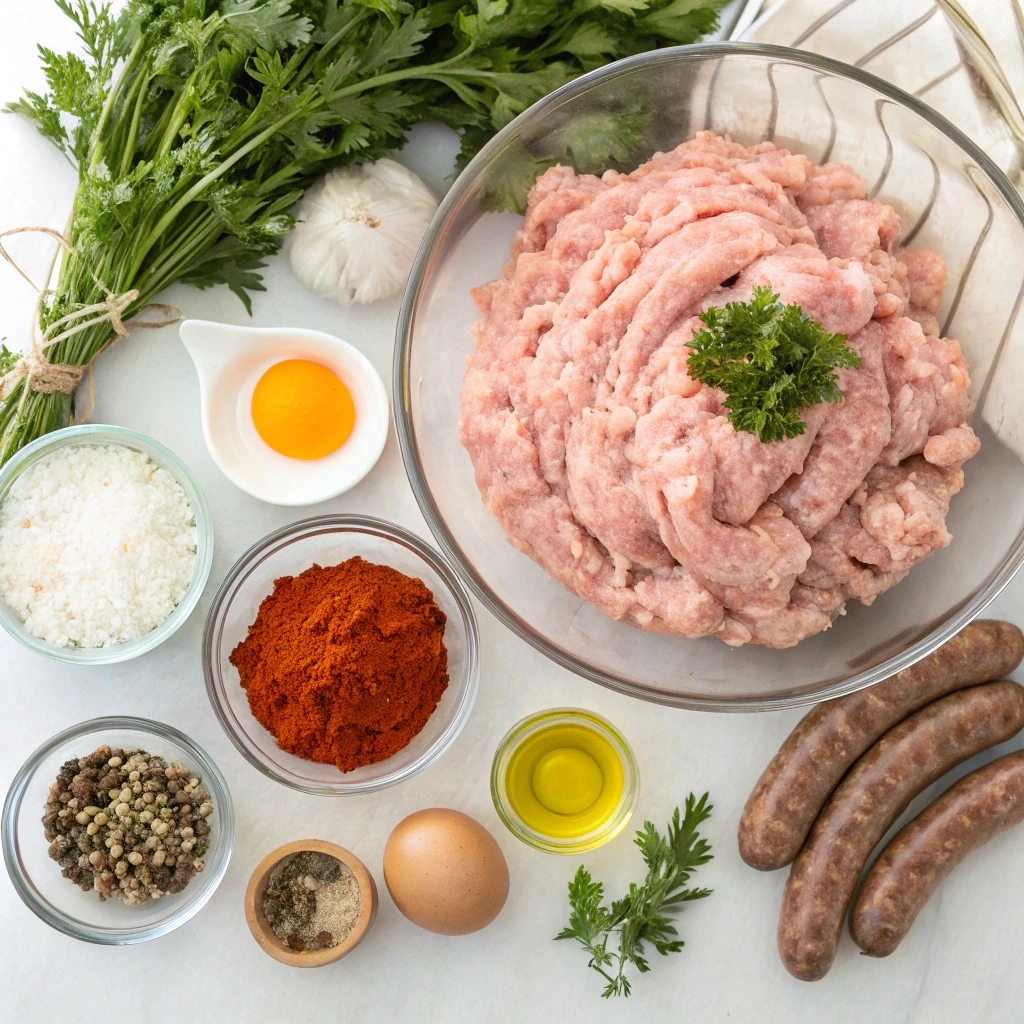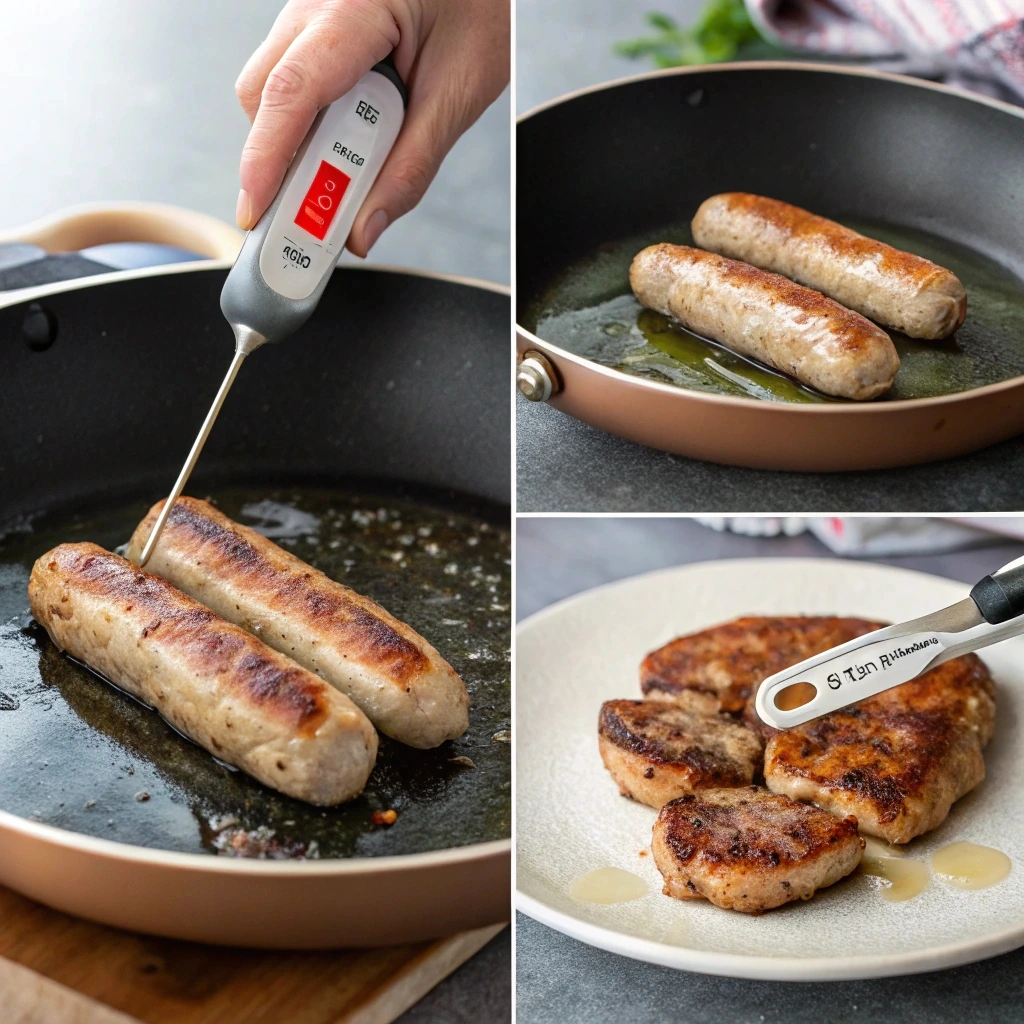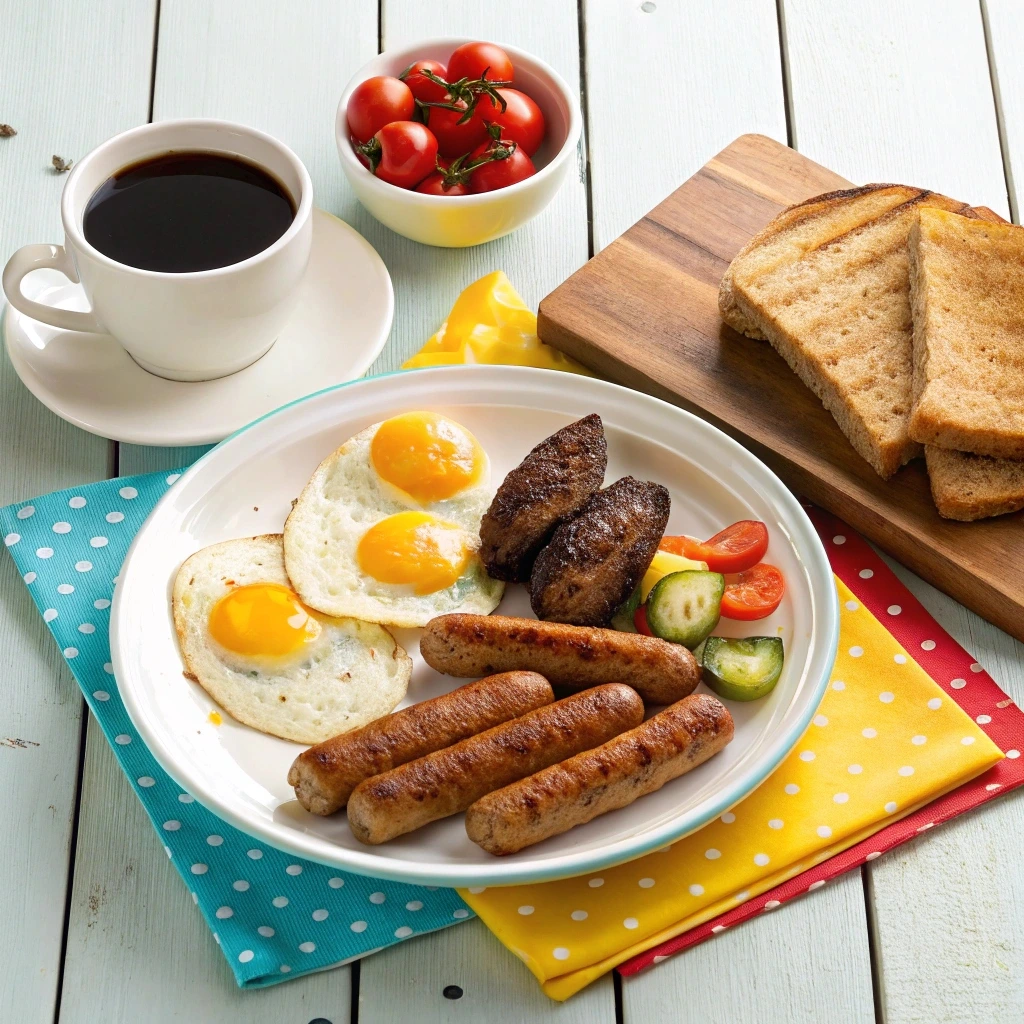Mornings can be hectic, but that doesn’t mean you have to compromise on flavor—or health—when it comes to breakfast. Whether you’re looking for a leaner alternative to pork, following a specific diet, or just trying to spice up your morning routine, chicken breakfast sausage is a mouthwatering solution.
This guide dives deep into everything you need to know about this protein-packed option. We’ll explore health benefits, top brands, delicious recipes, smart buying tips, and even insider cooking tricks to help you get the best sear every time. You’ll also get answers to the most frequently asked questions straight from the web’s “People Also Ask” box.
Let’s start with the basics.
Table of Contents
Introduction to Chicken Breakfast Sausage
What Is Chicken Breakfast Sausage?
Simply put, chicken breakfast sausage is a lighter, leaner twist on the traditional pork sausage we all know and love. Made primarily from ground chicken meat and seasoned with a mix of herbs and spices, these sausages are often lower in fat and calories. You’ll find them in various flavors, from classic savory to sweet apple or even spicy chipotle.
Unlike pork sausages, which can feel heavy, chicken sausage links are light, juicy, and versatile. Whether served on a plate with eggs and toast or tucked into a wrap on the go, they offer a satisfying bite that won’t weigh you down. Many brands now offer gluten-free, keto-friendly, and nitrate-free options, making them accessible for a wide range of diets.
Why Choose Chicken Over Pork or Beef for Breakfast?
Health is a biggie here. Compared to pork, chicken is naturally lower in saturated fat and cholesterol. For folks watching their weight or heart health, that’s a clear win. Plus, many chicken sausages pack more protein per calorie, making them ideal for high-protein breakfast meals.
Moreover, the flavor is anything but boring. Thanks to creative seasoning blends—think fennel, garlic, or even maple syrup—chicken sausage brings bold taste without the guilt. And because it cooks quickly, it’s a no-fuss option that fits right into your busy morning.
Health Benefits of Chicken Breakfast Sausage
Lower Fat, High Protein: A Leaner Alternative
Let’s be real—most of us want breakfast that tastes great and won’t leave us feeling sluggish. That’s where chicken breakfast sausage really shines. Compared to pork or beef sausage, chicken is naturally leaner. As a result, it contains less saturated fat and fewer calories, yet still satisfies with juicy texture and savory flavor.
For example, a typical pork sausage link can pack up to 250 calories and 20 grams of fat. However, a chicken sausage link usually has just 100–160 calories and only 6–8 grams of fat. That’s a big difference if you’re watching your macros.
Moreover, chicken sausage tends to be higher in protein per calorie. This makes it a solid option for folks trying to maintain muscle mass or boost energy levels first thing in the morning.
Chicken Sausage for Special Diets: Keto, Gluten-Free, and Paleo
Trying to eat clean? You’re in luck. Many chicken breakfast sausage products are made for specific diets. For example, you’ll find varieties that are Whole30 approved, gluten-free, or paleo-friendly.
Even better, several brands offer nitrate-free and antibiotic-free options. Therefore, you don’t have to sacrifice your health goals for convenience or taste.
Additionally, if you’re cutting carbs, many options contain zero sugar and only 1–2 grams of carbs per serving. That fits beautifully into low-carb meal plans like keto.
In short, chicken breakfast sausage is one of the smartest choices for health-conscious eaters. You get all the savory satisfaction of sausage—without the guilt.
Popular Brands and Product Comparisons
Top Chicken Breakfast Sausage Brands in 2024
The market is full of chicken breakfast sausage options, but not all are created equal. Some brands use cleaner ingredients, better flavor combos, and higher protein content. Below are a few fan favorites, based on reviews and expert taste tests:
| Brand | Flavor/Type | Calories (Per Link) | Protein | Notable Features |
|---|---|---|---|---|
| Applegate | Chicken & Apple | 150 | 11g | Organic, Gluten-Free, Sweet Flavor |
| Al Fresco | Sweet Italian | 110 | 13g | Pork casing, Mild & Sweet |
| Amylu | Roasted Garlic & Asiago | 160 | 14g | Cheese-Infused, Antibiotic-Free |
| Whole Foods (365) | Mild Italian | 140 | 14g | Organic, Basil and Pepper Blend |
| Nature’s Promise | Sweet Italian | 80 | 13g | Low Calorie, USDA Organic |
Therefore, when shopping, it’s a good idea to scan the ingredient list. Look for short, clean labels with recognizable components. Avoid unnecessary sugars, fillers, and artificial flavors.
Store-Bought vs. Homemade: Taste, Texture, and Nutrition
While store-bought sausages are quick and easy, homemade versions give you full control. For instance, you can tweak the salt, fat content, and spices. Better still, making your own means no preservatives or additives.

Here’s a basic homemade chicken breakfast sausage recipe:
| Ingredient | Quantity |
|---|---|
| Ground chicken (lean) | 1 lb (450 g) |
| Garlic powder | 1 tsp |
| Onion powder | 1 tsp |
| Fennel seeds (crushed) | 1/2 tsp |
| Smoked paprika | 1/2 tsp |
| Ground black pepper | 1/4 tsp |
| Salt | 3/4 tsp |
| Dried thyme | 1/2 tsp |
| Maple syrup (optional) | 1 tsp |
Mix everything together and form into small patties. You can fry them in a nonstick skillet for about 3 minutes per side. Easy, flavorful, and better for you!
In conclusion, while store-bought chicken breakfast sausage offers convenience, homemade gives you that extra edge in health and customization. Either way, it’s a delicious step toward smarter mornings.
Cooking Methods for Chicken Breakfast Sausage
How to Cook Chicken Breakfast Sausage on the Stove, Grill, and Oven
No one likes a rubbery sausage—or worse, a dry one. Fortunately, chicken breakfast sausage cooks up beautifully with just a bit of care. Let’s walk through three foolproof cooking methods.
1. Stovetop (Pan-Frying)
Pan-frying is quick, giving the sausage that golden-brown crust we all love. Add a dash of oil to a skillet over medium heat. Cook the sausages for 6–8 minutes, flipping halfway. They should be browned and reach an internal temp of 165°F.
2. Oven Baking
For hands-free cooking, baking is perfect. Preheat your oven to 375°F (190°C). Place sausages on a baking sheet lined with parchment paper. Bake for 20 minutes, turning them once at the halfway mark. They’ll come out juicy with a firm bite.
3. Grilling
Want a smoky twist? Toss your chicken sausage on a grill. Set it to medium heat. Grill links for 10–12 minutes, turning often for even char marks. This method adds a bold, barbecue-like flavor that’s hard to resist.
Whichever method you choose, just don’t overcook—it’s the easiest way to ruin a great sausage.
Tips for Achieving the Perfect Crisp Without Drying Out the Meat
Here’s the deal: chicken breakfast sausage has less fat than pork, so it dries out faster. But with these tips, you’ll lock in flavor and texture:
- Always bring sausages to room temp before cooking.
- Use a lid briefly to steam during pan-frying, then finish uncovered for that crispy skin.
- Avoid stabbing or cutting the sausage too early—it releases juices.

And here’s a tasty tip: serve your sausage with scrambled eggs or pancakes. Or better yet, check out these Chicken Apple Sausage Recipes for flavorful pairing ideas!
Chicken Sausage Breakfast Recipes
Easy Chicken Sausage and Egg Breakfast Skillet
If you’re craving a protein-packed breakfast that’s ready in 20 minutes, this skillet is a winner. It’s hearty, easy to clean up, and loaded with flavor.
Ingredients
| Ingredient | Quantity |
|---|---|
| Chicken breakfast sausage | 4 links (sliced) |
| Eggs | 4 large |
| Bell pepper (diced) | 1 cup |
| Onion (chopped) | 1/2 cup |
| Olive oil | 1 tbsp |
| Salt and pepper | To taste |
| Fresh parsley (optional) | For garnish |
Instructions
- Heat olive oil in a skillet over medium heat.
- Sauté onions and bell peppers for 3–4 minutes.
- Add sliced chicken breakfast sausage and cook until browned.
- Push everything to the side and crack in the eggs. Scramble them in the same pan.
- Mix it all together, season, and serve hot!
It’s a perfect one-pan breakfast that’s both quick and satisfying.
Low-Carb Chicken Sausage Breakfast Burrito
Missing burritos on keto? Don’t worry—this version skips the tortilla but keeps all the taste. It’s stuffed with eggs, veggies, and chicken sausage, rolled in a lettuce leaf or low-carb wrap.
Ingredients
| Ingredient | Quantity |
|---|---|
| Chicken sausage links | 2 (sliced thin) |
| Scrambled eggs | 2 |
| Spinach or kale | 1/2 cup (cooked) |
| Cheese (cheddar or mozzarella) | 1/4 cup |
| Lettuce wrap or low-carb wrap | 1 per burrito |
| Hot sauce (optional) | To taste |
Instructions
- Sauté sausage until lightly crisped.
- Add spinach or kale and cook until wilted.
- Warm your wrap, then layer the sausage mix, eggs, and cheese.
- Roll it up tightly and serve with hot sauce.
This burrito is not only filling but also works great as a meal prep idea.
Ingredient Guide and Label Reading Tips
What to Look for on Chicken Sausage Packaging
Reading food labels can feel like decoding a puzzle, but when it comes to chicken breakfast sausage, it’s actually pretty simple—once you know what to watch for. First things first, always check the ingredient list. Shorter is better. Ideally, the label should include only ground chicken, herbs, spices, and maybe a touch of natural sweetener like maple syrup.
Moreover, avoid terms like “mechanically separated meat” or “flavor enhancers.” These often signal a heavily processed product. Instead, look for words like “organic,” “nitrate-free,” or “no antibiotics ever.” These are great indicators of a cleaner, healthier sausage.
Additionally, examine the nutrition label. A solid serving of chicken sausage should contain around 100–150 calories, 10–15 grams of protein, and low saturated fat. Watch the sodium, though—some brands sneak in over 600 mg per link!
Avoiding Additives: What Ingredients to Watch Out For
While many brands keep it clean, others add fillers and preservatives that can take a toll on your health over time. Therefore, steer clear of:
- High fructose corn syrup
- Sodium nitrate/nitrite
- Artificial coloring
- Excess sugars
These don’t belong in your chicken breakfast sausage. If you spot ingredients you can’t pronounce, it’s probably a sign to move on.
For a better pick, go for sausages that are labeled “minimally processed” or “whole food ingredients.” It’s a small step that can make a big difference in your overall health—especially if you enjoy sausage regularly.
Flavor Variations and Seasonings in Chicken Sausages
From Sweet to Spicy: Popular Flavor Profiles
Gone are the days when sausage only came in “original” or “hot.” Today’s chicken breakfast sausage market is bursting with flavor. For example, sweet varieties often include ingredients like apple, maple syrup, or brown sugar, making them perfect for pairing with pancakes or waffles.
On the flip side, spicy lovers will find plenty to crave—think jalapeño cheddar, chipotle, or buffalo-style chicken sausage. These bring the heat and are great in burritos or breakfast bowls.
More traditional options, like Italian-style chicken sausage, often feature fennel, garlic, and oregano, giving that classic breakfast flavor without the pork.
Pairing Chicken Sausage with Herbs and Spices
The seasoning possibilities are endless. When making sausage at home or buying fresh from a butcher, consider combining chicken breakfast sausage with spices like:
- Smoked paprika for a rich depth
- Sage for a classic breakfast vibe
- Thyme and rosemary for a more earthy flavor
- Crushed red pepper for heat
Therefore, the right seasoning blend can elevate your sausage from simple to sensational. You don’t always need fancy ingredients—a well-balanced mix of herbs goes a long way.
If you’re experimenting in the kitchen, try pairing your sausage with unexpected flavors like curry powder or lemon zest for a modern twist. It’s a tasty way to keep breakfast exciting, especially when you’re cooking for picky eaters or adventurous foodies.
Buying Tips and Storage Recommendations
Where to Buy the Best Chicken Breakfast Sausage
Finding the right chicken breakfast sausage doesn’t have to be a chore. You can grab it at most grocery stores these days—especially in the refrigerated or freezer section. Popular chains like Whole Foods, Trader Joe’s, and Costco usually carry several well-reviewed brands. Additionally, if you’re into clean eating, look in the organic or specialty aisle.
Moreover, online retailers like Amazon Fresh or ButcherBox offer curated sausage packs, often made with antibiotic-free or pasture-raised chicken. That’s a win if you want quality meat delivered to your door.
Pro tip: If your local butcher makes their own sausage, ask about their ingredients. Chances are, they’ll be fresher and contain fewer preservatives.
How to Store Fresh vs. Cooked Sausages Safely
Proper storage can make or break the shelf life of chicken sausage. Uncooked links should go straight into the fridge and be used within 2–3 days—or freeze them for up to 2 months. Always check the “use by” date on the packaging.
On the other hand, once you’ve cooked your chicken breakfast sausage, store leftovers in an airtight container. They’ll last about 3–4 days in the fridge. To reheat, simply microwave or pan-fry for a few minutes until warmed through.
And here’s a tip: avoid reheating multiple times, as it can dry out the meat and dull the flavors.
Consumer Reviews and Taste Tests
Top-Rated Chicken Sausages According to Experts
When it comes to choosing the best chicken breakfast sausage, expert reviews can really help narrow things down. According to taste tests from sources like Eat This, Not That and various food blogs, brands like Applegate, Al Fresco, and Amylu consistently rank high for both flavor and texture.
For example, Applegate’s Chicken & Apple sausage has been praised for its balance of sweet and savory. Meanwhile, Amylu’s Garlic & Asiago links deliver rich, cheesy goodness without being greasy. Experts often note that chicken sausage from these brands tastes less processed and more “real.”
Public Opinions on Taste, Texture, and Versatility
Beyond the experts, real customers have a lot to say. Many shoppers love how versatile chicken breakfast sausage is. It works well in egg bakes, wraps, and even pasta dishes. Plus, most people appreciate the lighter feel compared to pork.
However, not all feedback is glowing. Some brands get called out for being too rubbery or overly sweet. Therefore, reading both positive and negative reviews before buying can help you avoid disappointment.
In the end, everyone’s taste buds are different. Trying a few brands and flavors is the best way to find your favorite.

FAQs About Chicken Breakfast Sausage
Is Chicken Breakfast Sausage Healthier Than Pork Sausage?
Yes, in most cases, it is. Chicken breakfast sausage is often seen as the healthier choice because it usually contains less saturated fat and fewer calories than traditional pork sausage. For example, many chicken sausage links have only 100–150 calories, compared to over 200 in pork.
Moreover, chicken is a leaner meat, which makes it great for those watching their weight or trying to reduce cholesterol. However, it still depends on the brand. Some chicken sausages add sugar, preservatives, or sodium—so always read the label.
Can You Eat Chicken Sausage for Breakfast Every Day?
You can—but with balance. Eating chicken breakfast sausage daily is fine if you’re choosing clean brands without additives and pairing it with fiber-rich foods like veggies or whole grains.
However, variety matters. So, it’s still smart to rotate your proteins to avoid overdoing it on sodium or processed meats.
How Long Does Chicken Breakfast Sausage Last in the Fridge?
That depends. If it’s uncooked and still sealed, it usually lasts about 3–5 days in the fridge. Once opened or cooked, try to eat it within 3–4 days.
If you’re not planning to eat it soon, freezing is a safe bet. Just be sure to use it within 1–2 months for the best flavor.
Is Chicken Sausage Pre-Cooked?
Sometimes, yes. Many brands offer fully cooked chicken breakfast sausage, which makes it super convenient. However, some are raw and need full cooking.
Therefore, always check the label. It’ll say clearly whether it’s ready-to-eat or not. If unsure, cook to an internal temperature of 165°F to be safe.

